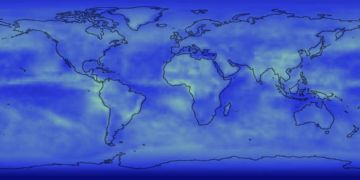
 |
||
|
|
||
| View other datasets |
|
|
| ||
 |
|||
| Coverage of this dataset spans November 1984 to September 2005. | |||
The animation features of the Earth Observatory are currently unavailable. We apologize for the inconvenience. To view the full temporal span of this dataset, please view the Reflected Shortwave Radiation monthly holdings. | |||
 Product description: A portion of the sunlight that enters the Earth system is reflected back into space by a combination of the clouds, aerosols, and gases in the atmosphere, as well as from the surface. The term "reflected shortwave radiation" refers to the sum total of all the shortwave electromagnetic energy, or sunlight at wavelengths ranging from 0.3 to 5 micrometers, that escapes from the top of the Earth's atmosphere back into space. The image above is a false-color map showing the amount of shortwave energy (in Watts per square meter) that was reflected by the Earth system for the given month(s). In the image, the brighter, whiter regions show where more sunlight is reflected, while green regions show intermediate values, and blue regions are lower values. Notice that regions that are typically cloudy tend to reflect more shortwave energy, while the land surface reflects less than clouds, and the ocean reflects less than the land. All of the images in this dataset up to and including February 1990 were acquired by the Earth Radiation Budget Experiment (ERBE) sensor and all of the images from March 2000 onward were acquired by the Clouds and the Earth's Radiant Energy System (CERES) sensor aboard NASA's Terra satellite. (Data courtesy ERBE and CERES Projects, NASA LaRC)
|
|
Subscribe to the Earth Observatory About the Earth Observatory Contact Us Privacy Policy and Important Notices Responsible NASA Official: Lorraine A. Remer Webmaster: Goran Halusa We're a part of the Science Mission Directorate |